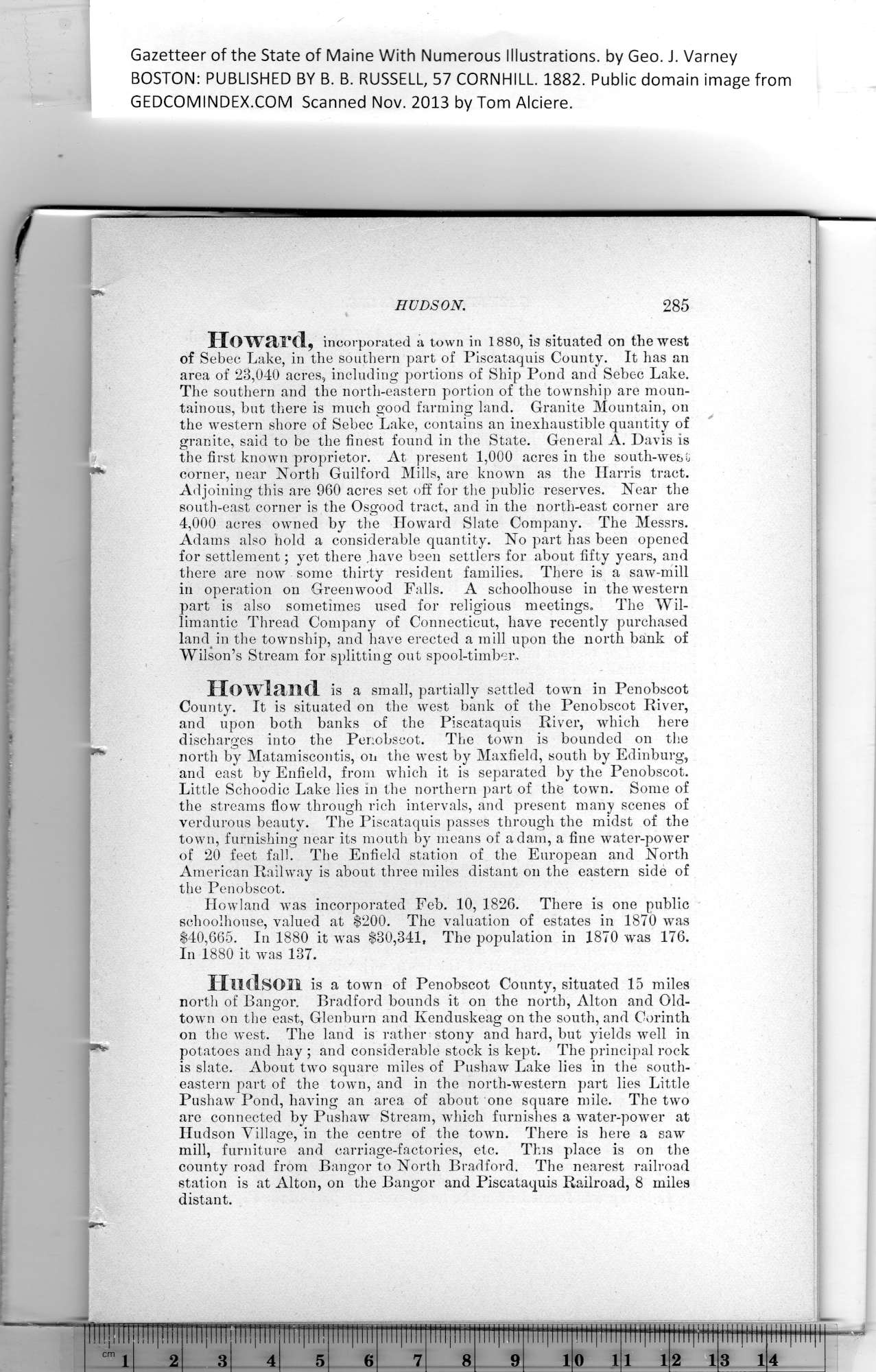|
Gazetteer of the State of Maine With Numerous Illustrations, by Geo. J. Varney
BOSTON: PUBLISHED BY B. B. RUSSELL, 57 CORNHILL. 1882. Public domain image from
HUDSON.
Howard, incorporated a town in 1880, is situated on the west
of Sebec Lake, in the southern part of Piscataquis County. It has an
area of 23,040 acres, including portions of Ship Pond and Sebec Lake.
The southern and the north-eastern portion of the township are moun-
tainous, but there is much good farming land. Granite Mountain, on
the western shore of Sebec Lake, contains an inexhaustible quantity of
granite, said to be the finest found in the State. General A. Davis is
the first known proprietor. At present 1,000 acres in the south-we&t
corner, near North Guilford Mills, are known as the Harris tract.
Adjoining this are 960 acres set off for the public reserves. Near the
south-east corner is the Osgood tract, and in the north-east corner are
4,000 acres owned by the Howard Slate Company. The Messrs.
Adams also hold a considerable quantity. No part has been opened
for settlement; yet there .have been settlers for about fifty years, and
there are now some thirty resident families. There is a saw-mill
in operation on Greenwood Falls. A schoolhouse in the western
part is also sometimes used for religious meetings. The Wil-
limantie Thread Company of Connecticut, have recently purchased
landin the township, and have erected a mill upon the north bank of
Wilson’s Stream for splitting out spool-timber.
Howland is a small, partially settled town in Penobscot
County. It is situated on the west bank of the Penobscot River,
and upon both banks of the Piscataquis River, which here
discharges into the Penobscot. The town is bounded on the
north by Matamiscontis, on the west by Maxfield, south by Edinburg,
and east by Enfield, from which it is separated by the Penobscot.
Little Schoodic Lake lies in the northern part of the town. Some of
the streams flow through rich intervals, and present many scenes of
verdurous beauty. The Piscataquis passes through the midst of the
town, furnishing near its mouth by means of a dam, a fine water-power
of 20 feet fall. The Enfield station of the European and North
American Railway is about three miles distant on the eastern side of
the Penobscot.
Howland was incorporated Feb. 10, 1826. There is one public
schoolhouse, valued at $200. The valuation of estates in 1870 was
$40,665. In 1880 it was $30,341, The population in 1870 w^as 176.
In 1880 it was 137.
Hudson is a town of Penobscot County, situated 15 miles
north of Bangor. Bradford bounds it on the north, Alton and Old-
town on the east, Glenburn and Kenduskeag on the south, and Corinth
on the west. The land is rather stony and hard, but yields well in
potatoes and hay ; and considerable stock is kept. The principal rock
is slate. About two square miles of Pushaw Lake lies in the south-
eastern part of the town, and in the north-western part lies Little
Pushaw Pond, having an area of about one square mile. The two
are connected by Pushaw Stream, which furnishes a water-power at
Hudson Village, in the centre of the town. There is here a saw
mill, furniture and carriage-factories, etc. This place is on the
county road from Bangor to North Bradford. The nearest railroad
station is at Alton, on the Bangor and Piscataquis Railroad, 8 miles
distant.
PREVIOUS PAGE ... NEXT PAGE
This page was written in HTML using a program written in Python 3.2
|
